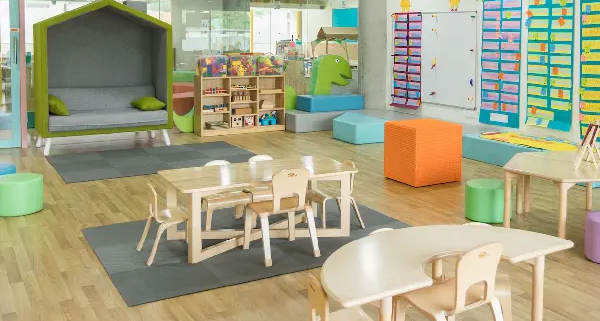Sample Site Assessment Checklist
This checklist is not exhaustive. It is meant to be a starting point and should be adapted to meet the individual needs of each facility.
Room security
- Room access is secured so children cannot enter or leave without supervision.
- Staircases are blocked with childproof gates to prevent falls.
- Staff have a clear view of the entire room, with no blind spots where a child could be out of sight.
- Rooms may be monitored via windows to the room that offer a clear view of the entire room.
Play area
- Play area is clean.
- Clutter free.
- Games and toys are vetted for choking hazards in areas that young children access.
- All toys and other items are in good condition, with no peeling paint, cracks, loose parts, sharp edges, or other hazards.
- Toys are sanitized daily.
Infant area
- Infant sleeping furniture is SIDS-proof. They are free of pillows, stuffed animals, bumpers, loose blankets or anything else that could obstruct an airway.
- Infant furniture is cleaned and sanitized frequently.
- The diapering area has clear line of sight to the entire room.
Bathroom
- Bathrooms are in good working order.
- Toddler size toilets are used for younger children.
- Toilet stalls offer privacy to the children using them.
Furnishings and fixtures
- All furniture, equipment, and décor are clean and well-maintained, with no peeling paint or loose parts.
- All furniture and fixtures are sturdy and secured to the wall or floor, so they do not present a tipping hazard.
- Rugs are non-skid, either taped to the floor with double-sided tape or placed on top of a non-skid mat.
- Any hot surfaces, like a stovetop, are out of the reach of a child.
- Electrical outlets are covered with safety caps when not in use.
Safety equipment
- First-aid kits are readily available to all areas where youth are present. Kits are frequently checked for missing items. Kits contain bandages/gauze, thermometer, tweezers, and alcohol wipes.
- Check the center for recalled products and replace them when discovered.
- Keep fire safety equipment on hand and have it tested/maintained on a regular basis. Test smoke detectors monthly.
- An evacuation plan is in place and posted in every room.
Outdoor areas
- All outdoor areas offer a clear line of sight to all children, with no blind spots.
- Outdoor areas are securely fenced to prevent outside access.
- Fences are not climbable.
- The play area has enough space for children to play without colliding with anything.
- Outside areas are free of trash, yard debris and animal waste.
Play equipment
- Play equipment is in good working order with no loose screws, sharp edges or other hazards.
- Equipment is securely attached to the ground to ensure it’s sturdy and can support the weight of the children.
- Metal equipment, like slides, are in shady area to burns on sunny days.
- Elevated platforms have secure guard rails to prevent falls.
Michelle Markgraf, Freedom for the Captives
- Step One: Form a Child Safety Committee
- Step Two: Create Urgency
- Step Three: Know Your Volunteers
- Sample Site Assessment Checklist
- Step Four: Assess Your Space
- Sample Standards for Interactions with Minors and/or Vulnerable Adults
- Step Five: Implement Guidelines for Youth Leaders
- Step Six: Train adults to recognize and respond to abuse
- Step Seven: Support abuse survivors
- Step Eight: Create guidelines for responding to abuse
- Step Nine: Educate children about personal safety
- Step Ten: Review and maintain your child protection program




